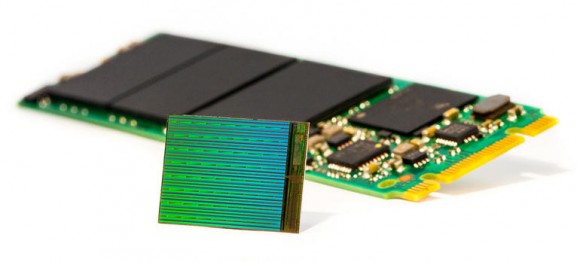Intel and Micron have new flash memory chips announced that will provide up to three times the capacity of chips currently in use. They are based on a 3D stacking technique called the Samsung had presented last year. According to Intel, can such a flash memory with a capacity of 3.5 TB be implemented in the size of a gum strip.
In addition, Toshiba has announced a 3D NAND chip to have similar capacities as the products currently offered by Samsung. This Samsung taken a unique feature, which could lead to a new price war.

3D NAND flash chip from Intel and Micron (Picture: Intel).
“3D is one of the ways to keep it going Moore’s Law,” said Michael Jackson, Professor of Microelectronic Engineering at the Rochester Institute of Technology. He is referring to observations of the Intel co-founder Gordon Moore to the development of the processor technology, which states that the complexity of integrated circuits within a certain time, depending on the source of 12 to 24 months, the speech doubled regularly.
The increase in capacity is achieved with 3D Nand fact that more bits can be stored in a memory cell. Intel and Micron will initially offer 256-Gbit chips with 2 bits per cell. To follow later in which a cell can accommodate 3 bits 384-Gbit chips. Toshiba turn stores two bits per cell in its 128-Gbit chips.
So far, the capacity of flash memory chips was increased by the fact that more and more memory cells were placed on a two-dimensional chip surface. Intel and Micron now follow Samsung’s approach with 32 layers of flash memory. Toshiba comes with 48 layers even one step further. All three companies provide immediate first pattern of their new 3D NAND memory chip. Intel and Micron want to bring the finished product later this year on the market. It can be used in smartphones and also in Solid State Drive.
Intel and Micron have teamed up to compete together against the market leader Samsung. Intel had loud Statista last year a market share of 8 percent, Micron came to 14 percent. Toshiba’s share accordingly declined to 22 percent. Samsung secured in 2014 28 per cent of the market.
IBM develops, however, an alternative to Flash called phase change memory. HGST last year already is than conventional SSDs showed a first SSD with phase change memory that can process data requests several times faster. The start-up Crossbar again relies Resistive RAM. The technology will allow up to one terabyte of memory on a single chip.
[With material by Stephen Shankland, News.com]
No comments:
Post a Comment